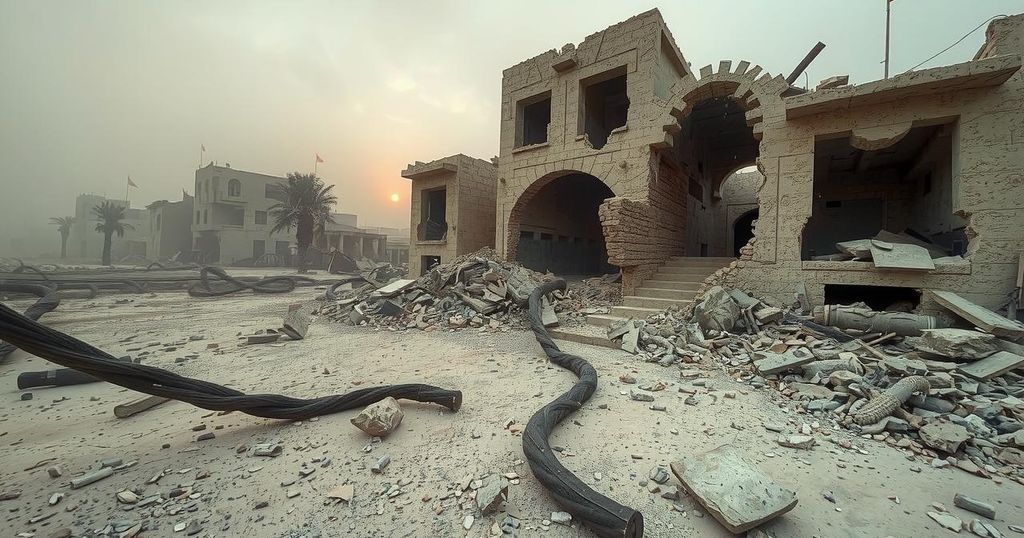The article reviews the Battle of Mogadishu, a significant conflict in 1993 where American troops faced substantial casualties while attempting to assist Somalia amid famine. The operation ended in failure, leading to the withdrawal of U.S. forces and raising critical questions about foreign military interventions. Notably, the humanitarian crisis in Somalia persists, with millions still affected by malnutrition and conflict.
The prolonged civil unrest in Somalia has historically led to severe food insecurity, recalling past interventions such as the 1993 Battle of Mogadishu. This conflict saw the United States, under UN aegis, attempting to mitigate famine, resulting in the loss of two Black Hawk helicopters and 18 American soldiers’ lives.
In 1992, the United Nations implemented the United Nations Operation in Somalia (UNOSOM) to address ongoing civil strife and hunger. Alongside, the UN initiated Operation Provide Relief to deliver much-needed food aid. Unfortunately, the rampant violence obstructed these efforts, leading to a shift in strategy.
In December 1992, Operation Restore Hope was launched by the United States, endorsed by President George H.W. Bush, to assist with famine relief. This operation transitioned into the United Nations’ United Task Force (UNITAF), which possessed the authority to use force to ensure aid delivery. By March 1993, this evolved into UNOSOM II, which aimed to restore democracy amid the chaos, directly opposing the Somali National Alliance (SNA) led by General Aidid.
As UNOSOM II aimed to stabilize the region, it faced aggressive opposition from Aidid’s militia. A notable ambush occurred in June 1993, where Pakistani troops were attacked, intensifying hostilities and marking a critical turning point for UN forces. Subsequently, hostilities escalated as UNOSOM and SNA engaged in intense combat.
The United States’ Task Force Ranger initiated Operation Gothic Serpent in August 1993, aiming to capture Aidid. On October 3, intelligence indicated a meeting location which prompted an assault by U.S. troops, yet the operation quickly deteriorated. SNA forces downed two Black Hawk helicopters, resulting in significant casualties and fierce engagements with U.S. soldiers.
The aftermath of the Battle of Mogadishu led to a public outcry in the United States. President Bill Clinton’s declaration to withdraw American forces followed shortly after the battle which resulted in the death of 18 soldiers and countless Somalis. This incident is regarded as the bloodiest day for U.S. troops since Vietnam, prompting a reevaluation of U.S. military involvement in global peacekeeping.
While the U.S. Army considers the battle a tactical success due to the significant resistance faced against a numerically superior foe, it nonetheless prompted serious reconsiderations of foreign policy. Mark Bowden’s 1999 book, “Black Hawk Down,” and its subsequent film adaptation renewed public interest in these events.
Despite nearly three decades since these events, Somalia continues to grapple with conflict and potential famine. The World Food Program has reported alarming statistics regarding malnutrition among children, highlighting the ongoing humanitarian crisis. As of late 2025, 1.7 million children are projected to face acute malnutrition, underscoring the urgent need for international attention and resolution in the nation.
The Battle of Mogadishu remains a pivotal moment in U.S. military history, exemplifying the complexities of foreign intervention in conflict zones. While the operation aimed to secure stability and aid delivery in Somalia, it resulted in a tragic loss of life and significant shifts in U.S. foreign policy. The enduring hardships faced by Somalia reflect a continued humanitarian crisis that warrants persistent international engagement.
Original Source: www.eurasiantimes.com




